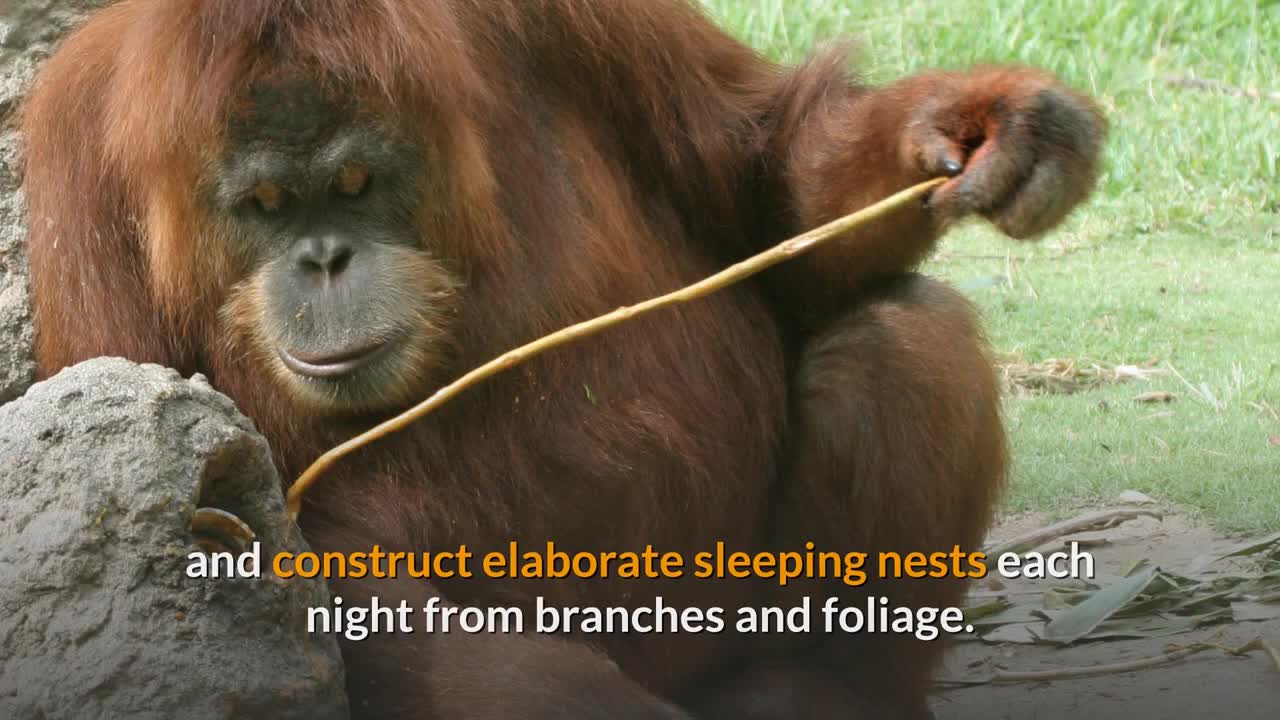Premium Only Content

Orangutan || Description, Characteristics and Facts!
Orangutans (genus Pongo, also spelled orang-utan, orangutang, or orang-utang) are great apes native to Indonesia and Malaysia. They are found in the rainforests of Borneo and Sumatra, but during the Pleistocene they ranged throughout Southeast Asia and South China. Classified in the genus Pongo, orangutans were originally considered to be one species. From 1996, they were divided into two species: the Bornean orangutan (P. pygmaeus, with three subspecies) and the Sumatran orangutan (P. abelii). In 2017, a third species, the Tapanuli orangutan (P. tapanuliensis), was identified. The orangutans are the only surviving species of the subfamily Ponginae, who split from humans, chimpanzees and gorillas 19.3 to 15.7 million years ago (mya).
The most arboreal of the great apes, orangutans spend most of their time in trees. They have proportionally long arms and short legs and their hair is reddish-brown. Adult males may develop distinctive cheek pads or flanges and make long calls that attract females and intimidate rivals; younger males do not and resemble adult females. Orangutans are the most solitary of the great apes, social bonds occurring primarily between mothers and their dependent offspring, who remain together for the first two years. Fruit is the most important component of an orangutan's diet, but they will also eat vegetation, bark, honey, insects and bird eggs. They can live over 30 years both in the wild and in captivity.
Orangutans are among the most intelligent primates. They use a variety of sophisticated tools and construct elaborate sleeping nests each night from branches and foliage. The apes' learning abilities have been studied extensively. There may be distinctive cultures within populations. Orangutans have been featured in literature and art since at least the 18th century, particularly in works which comment on human society. Field studies of the apes were pioneered by primatologist Birutė Galdikas and they have been kept in captive facilities around the world since at least the early 19th century. All three orangutan species are considered critically endangered. Human activities have caused severe declines in populations and ranges. Threats to wild orangutan populations include poaching, habitat destruction because of palm oil cultivation, and the illegal pet trade. Several conservation and rehabilitation organisations are dedicated to the survival of orangutans in the wild.
-
 7:07
7:07
Colion Noir
7 hours agoBill Removes Suppressors Off NFA Passes House | One Big Beautiful Bill
53.3K21 -
 22:35
22:35
Stephen Gardner
1 day agoBiden's GETS NIGHTMARE notice from Congress!
40.3K73 -
 2:06:40
2:06:40
TimcastIRL
6 hours agoVideo LEAKS Of Woke Judge AIDING Criminal Alien ESCAPE, Claims IMMUNITY | Timcast IRL
169K86 -
 1:43:18
1:43:18
Glenn Greenwald
8 hours agoGlenn Takes Your Questions on the Trump Admin's War with Harvard, Fallout from Wednesday's DC Killing, and More; Plus: Lee Fang on Epstein's Dark Legacy in the USVI | SYSTEM UPDATE #460
120K47 -
 2:51:54
2:51:54
megimu32
5 hours agoTGI...FORTNITE?!? Friday Night Chill!
34.1K3 -
 2:36:45
2:36:45
I_Came_With_Fire_Podcast
13 hours agoEDU DEPT LAYOFFS HALTED | BIDEN CANCER | NVIDIA CRIES | TRUMP
34.4K2 -
 1:17:06
1:17:06
BEK TV
1 day agoGOVERNMENT COVER-UPS EXPOSED: VACCINE RISKS, PESTICIDES, DIPLOMATIC ASSASSINATIONS & BIDEN SCANDALS
17.5K1 -
 2:18:18
2:18:18
TheSaltyCracker
6 hours agoLefties Are Killing Jews ReeEEEStream 05-23-25
104K223 -
 3:56:42
3:56:42
SynthTrax & DJ Cheezus Livestreams
14 hours agoFriday Night DJ MIX Livestream 80s Night SPECIAL EDITION with Variety Visuals
24.5K5 -
 7:57:37
7:57:37
OhHiMark1776
8 hours ago🟢05-23-25 ||||| Halo Multiplayer Rumble: No. 14 ||||| Halo MCC (2019)
19.2K4